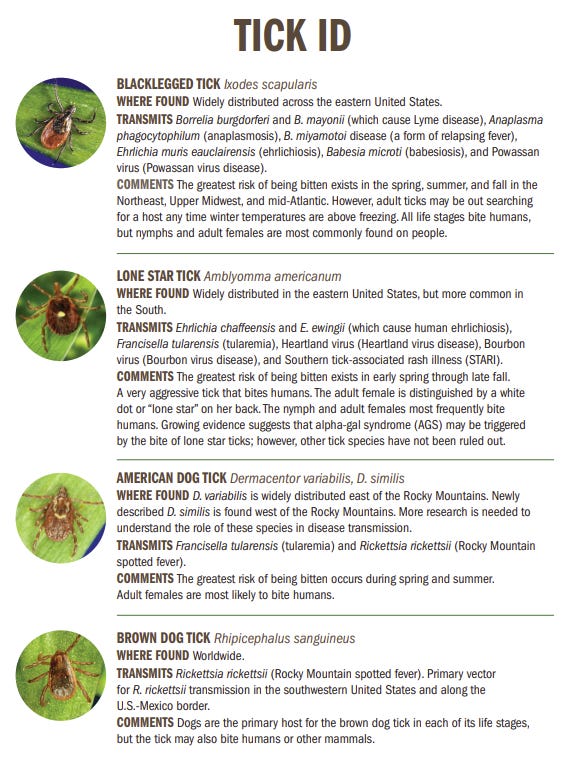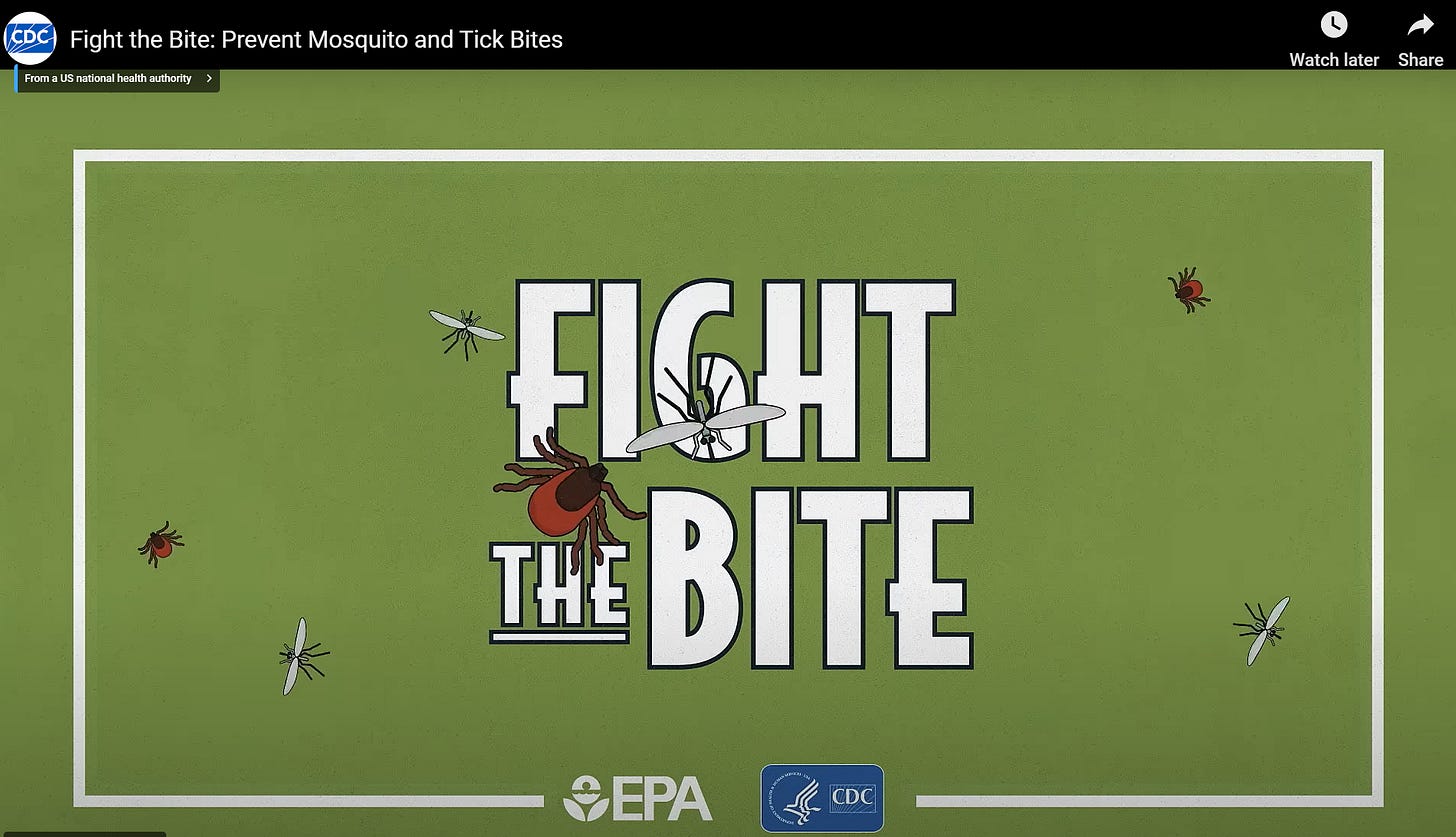A Warning from the Back Pasture
The Rising Threat of Vector-Borne Disease in a Warming America
Three evenings this past week, I took Bonnie our border collie to the pasture across the creek behind our home to work sheep for half an hour. Each night upon our return, I discovered a few ticks crawling on me.
Tracy and I live in Middle Tennessee, where the grasses are tall, the air is hot and humid, and early summer means the ticks are out in full force. I’ll confess up front: I haven’t been following the advice I offer below. I need to incorporate it into my life as much as anyone. But that’s part of the story.
More significantly, about six years ago, Tracy was diagnosed with alpha-gal syndrome. This was after two years and countless doctor visits struggling to find a diagnosis! At the time, hardly anyone had heard of alpha-gal. Even seasoned physicians struggled to piece it together. But the diagnosis, once made, explained everything. Today, with careful avoidance of red meat and pork, her symptoms have nearly disappeared. Still, the journey to clarity was long and frustrating. Alpha-gal is just one of many vector-borne diseases spreading across the United States.
So, ticks and the diseases they carry aren’t abstract for us—they’re personal. That’s why I’m authoring this article. Because we have lived the reality of expanding vector-borne disease. And because I want others to be prepared and thinking about how we can all stay healthy.
What is Vector-borne Disease?
Vector-borne diseases are diseases transported by small creatures, known as vectors, the most common being mosquitoes, ticks, and fleas. Generally, these diseases are transmitted through bites. For example, ticks carrying Lyme disease can transmit Lyme to humans by biting them. Naturally, ticks and mosquitoes are animals that prefer specific climates. A changing climate will mean alterations in the range of vectors and, consequently, the diseases they carry.
How Does the Changing Climate Play a Role?
Having dedicated my career to both medicine and public health I know firsthand the importance of taking preventive action to protect individuals and their families. The future of vector-borne diseases is not entirely predictable, in part because their spread depends on a complex web of environmental factors, including the habitats of the vectors and of the animals from which they acquire infections. Yet one trend is becoming increasingly clear: mosquitoes and ticks, the two most dangerous and common vectors of disease, are thriving in the face of rising temperatures. Warmer conditions, up to a certain threshold, accelerate their life cycles (meaning more rapid reproduction) and expand the ranges where they can survive.
Climate change is helping create new, more favorable environments for these vectors across the United States. Warm seasons are growing longer. Mosquitoes require standing water and warmth to breed. Ticks prefer humid, temperate climates. As regions begin to warm, the species are finding new territory, bringing with them illnesses like West Nile virus, Lyme disease, and others that pose real and growing threats to public health. For millions of Americans, this means greater chance of exposure, higher rates of infection, and increased pressure on our healthcare sector. Tackling the root cause—rising temperatures and changing climates—is one of the most powerful ways we can slow this alarming trend.
Examples of Vector-borne Diseases in the U.S.
Lyme Disease - Lyme disease is the most common vector-borne disease in the U.S. The CDC estimates that between 2010 and 2018, about 476,000 cases were diagnosed and treated in the U.S. The annual U.S. case counts have roughly doubled in the last 20 to 25 years. However, because Lyme symptoms—like fatigue, fever, and headaches—can look like other common illnesses, it is often mistaken for a cold or flu, and many people don’t seek medical help right away. It’s estimated that only about 10% of cases are actually documented. This is an enormous problem, because untreated Lyme disease can cause serious complications, including immune system problems, vision issues, numbness, and even paralysis. A small percentage of individuals who contract the disease develop chronic neurologic conditions; others go on to require hip replacement.
Originally found in the Northeast, Lyme disease is now spreading to regions that previously weren’t warm enough to support tick populations. Ticks carrying Lyme disease are moving into northern and even some southern regions. Although migration of deer and rodent populations contributes to this progressively expanding geography, scientists agree that a warming and more humid environment is a major factor.Anaplasmosis - Anaplasmosis, another tick-borne disease, is less common than Lyme but on the rise. Reported cases have grown from 348 in 1999 to over 7,000 in recent years. Like Lyme, early symptoms can be hard to identify, but if untreated, anaplasmosis can cause respiratory failure and inflammation of the brain. The same ticks that carry Lyme can transmit anaplasmosis, and infection with both can lead to more extreme symptoms.
Alpha-gal Syndrome - Alpha-gal syndrome (AGS), the condition that caused Tracy so much suffering, is a rapidly spreading allergy to red meat triggered by the bite of the Lone Star tick. People with AGS can have severe reactions like rashes, breathing difficulties, stomach pain, and even anaphylactic shock. AGS is most common in the Southeast but is spreading north as temperatures rise, allowing the Lone Star tick to expand its range. As we saw with Tracy’s case, many healthcare providers are unfamiliar with AGS, which makes it harder to diagnose and treat. A 2022 survey of American healthcare providers found that “42% had never heard of AGS” and another “35% reported they were ‘not too confident’ in their ability to diagnose AGS or… manage patients.”
West Nile Virus - West Nile virus, spread by mosquitoes, was first identified in North America in 1999. Since then, it has spread across most of the country. In 2024, West Nile virus was reported in 49 out of 50 states. Although many people with West Nile don’t experience symptoms, severe cases can cause high fever, chills, and inflammation of the brain or spinal cord, which can lead to paralysis or even death, especially in older adults. As temperatures rise, the mosquito species that carry West Nile is expanding its territory.
Dengue Fever - Dengue, also called “breakbone fever,” is a mosquito-borne illness that causes severe pain, high fever, and, in some cases, life-threatening complications like hemorrhagic fever and shock syndrome. Dengue has been documented in the U.S. since the 18th century but is spreading as warmer temperatures enable the mosquitoes that carry it to move further north. In 2024, over 5,600 cases of dengue fever were reported in the U.S., more than half of which were acquired locally. Puerto Rico suffered more heavily from the disease than any U.S. state—understandably, considering the island’s climate.

But… a Changing Climate Might Lower the Risk of Some Vector-borne Diseases
While climate change generally accelerates the spread of vector-borne diseases, there are exceptions. For example, some regions are becoming drier with climate change, which would thus reduce mosquito populations since mosquitoes require standing water to reproduce. Some researchers have posited that drier conditions may lower malaria risk in certain regions of Africa. However, as insects like mosquitoes adapt to survive drier climates, the benefits of this decrease could be short-lived.
What You Can Do to Protect Your Family
People often ask me, a physician and someone who lives in Tennessee where ticks especially are common, what they can do to protect themselves from vector-borne diseases. If you’re in an area with ticks, wear protective clothing and long pants, tucking them into your socks, use proper insect repellent, and systematically check for ticks after spending time outside.
Even with precautions, tick bites still happen, so it’s important to be aware of cold or flu-like symptoms that could signal an illness. If these are followed by symptoms less characteristic of a cold or flu, then consider the possibility of a vector-borne disease and proactively suggest this to your doctor. Early diagnosis and beginning antibiotic treatment quickly can lead to a fast recovery.
Avoiding mosquito bites is harder but using insect repellent and wearing protective clothing can help, especially near wetlands or still water.

Planetary Health Directly Impacts Human Health
The changing climate doesn’t just affect our environment; it impacts our individual health. Because of this, we have to think deeply about the long-term implications of how we interact with our environment, especially in an era where economic growth requires increased energy consumption. By taking steps to reduce greenhouse gas emissions, we can slow the changing temperature increases, limiting the potential for disease-carrying vectors to spread.
The first step is, of course, to reduce our reliance on fossil fuels and invest in sustainable, clean energy sources. Planting trees, conserving energy, and supporting policies that promote a healthier environment are investments not only in a stable climate, but also in the health and safety of our children. Wind, solar, and nuclear power are alternatives to fossil fuels that increasingly receive bipartisan support and are growing in popularity across the country.
For the health of our families, our communities, and our country, let’s each do our part and act now. Together, we can create a safer and healthier future for all.
And, in the meantime, I’ll do better with my own tick avoidance as I work Bonnie herding sheep in the back pasture.





We’re seeing the same thing up in Santa Barbara. The tick population exploded this spring and I’ve had more than one friend end up with mystery fevers that turned out to be early-stage Lyme. What really struck me here is how little even doctors know about things like alpha-gal. Climate’s changing fast, and it feels like our public health systems are still stuck in the past. Appreciate the reminder to stay alert,and not just to bugs, but to how environment and health are getting more tangled by the day.
Thank you for this article. I have lived in semi-rural Virginia nearly thirty years, and had my first deer tick encounter 3 years ago on our property, and a lone star tick bite just a month ago, I have taken to wearing permethrin-treated wrist bands and ankle bands when working in the garden, made from cutting a few inches off the top of old socks - a trick I learned from one of my teenage neighbors. - Doug Hendren